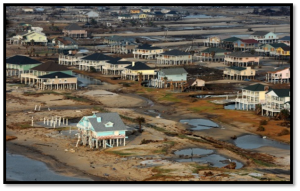State and municipal governments have many legal tools at their disposal to relocate vulnerable communities away from risky coasts, according to a new study released by the Columbia Law School Center for Climate Change Law.
Tuesday, October 29 , marked the first anniversary of Superstorm Sandy and its devastation of the east coast. Over the past year, city and community leaders have sought new policies to protect coastal infrastructure from storms and sea level rise. Among the range of options are engineering approaches such as seawalls, ecosystem approaches such as dunes, and social approaches such as moving communities away from vulnerable areas: managed retreat. Managed retreat can be a controversial concept as some fed-up homeowners seek to relocate and others to rebuild in the wake of a disaster.
, marked the first anniversary of Superstorm Sandy and its devastation of the east coast. Over the past year, city and community leaders have sought new policies to protect coastal infrastructure from storms and sea level rise. Among the range of options are engineering approaches such as seawalls, ecosystem approaches such as dunes, and social approaches such as moving communities away from vulnerable areas: managed retreat. Managed retreat can be a controversial concept as some fed-up homeowners seek to relocate and others to rebuild in the wake of a disaster.
The CCCL report, “Managed Coastal Retreat: A Legal Handbook on Shifting Development Away from Vulnerable Areas,” compiles and examines case studies from across the United States where communities have already implemented managed retreat to protect against future disasters. By cataloging potential tools and illustrating the practical situations in which managed retreat has been used, this handbook hopes to provide policy makers with better information on the pros and cons of managed retreat.
The handbook describes existing legal tools, state and local laws and regulations, and implementing policies that affected the success or failure of the program. Based on these studies, the guide also identifies a range of lessons learned to assist other communities improve their efforts. The guide is intended primarily as a resource for state and local policy makers along coasts and rivers, but the legal tools and lessons may also prove useful for communities facing other natural hazards.
The report was written by Anne Siders, associate director of Columbia Law School’s Center for Climate Change Law, under the direction of Professor Michael B. Gerrard, the Andrew Sabin Professor of Professional Practice and the center’s director. Numerous students actively participated in its preparation. The report was written in cooperation with Columbia Law School’s Environmental Law Clinic.
Image: Hurricane Ike Damage in Texas, from the Federal Emergency Management Agency, https://www.fema.gov/region-vi/new-modern-national-flood-insurance-program-nfip.


